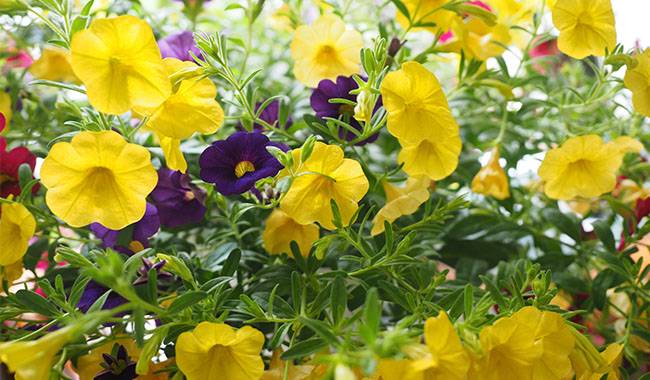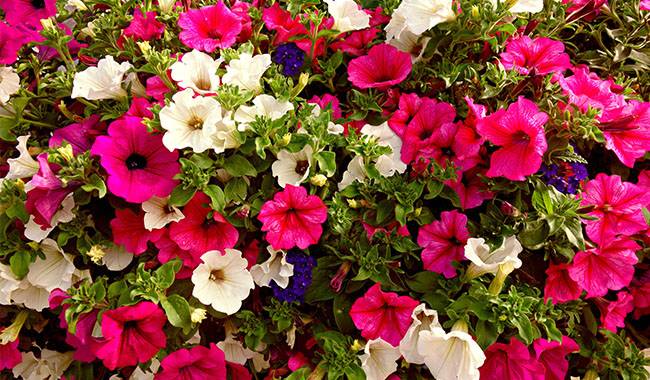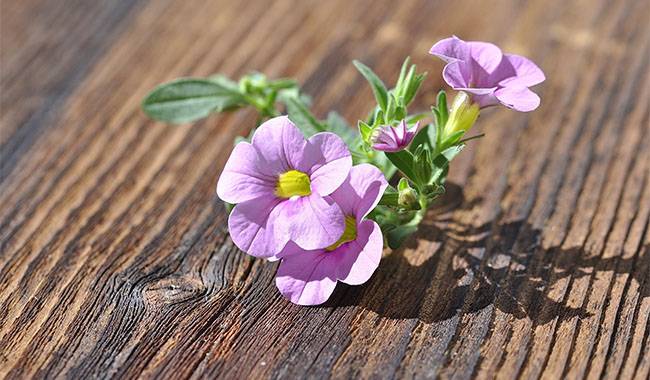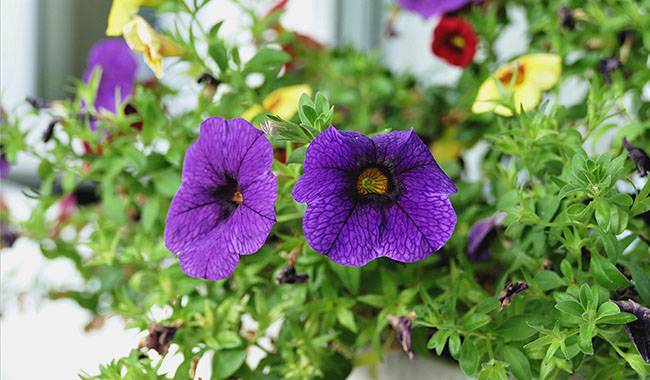
How to grow million bells, is a question that many friends will ask. A million bells (also known as Calibrachoa), Million bells is a flower that decorates many balconies and terraces, impressing with its lush, cascading beauty.
Not long ago, this plant, densely studded with bright little bells, was considered by many florists to be Calibrachoa (million bells).
You can also find Calibrachoa under this name in floriculture books until 1990 when it was placed in the genus Calibrachoa (million bells). Later, chromosomal differences between these cultivars regarding DNA structure were discovered by plant scientists.
Based on these studies, it was proven that Petunia and Calibrachoa (million bells) are related plants, but at the same time completely different. Beginners will find it useful to understand their external differences and how to properly care for and grow Calibrachoa (million bells).
WHAT DOES CALIBRACHOA LOOK LIKE
Visually, this flower is very similar to Calibrachoa (million bells), especially in the shape of the flower which is reminiscent of a phonograph. They are small, no more than 1-1.2inch (2.5-3 cm) in diameter, but this is completely compensated by their number.
Calibrachoa (million bells) is the name of one of these species (Calibrachoa (million bells)). The name adequately describes the appearance of this flower, which, when grown in hanging pots and vases, forms bushes with long, pendulous stems 20-40inch (about 0.5-1m) decorated with ornate bells scattered about.
TIP!
You can distinguish a calibrachoa bush from a Petunia bush by the two colors of the flowers. Regardless of the main color of the corolla, its “neck” is always brown or yellow.
Originally, Calibrachoa (million bells) could only please gardeners with its purple color, which is its original color. Over time, the plant caught the attention of breeders, who produced many hybrids in a variety of colors.
Now, you can see Calibrachoa (million bells) with corollas of white and yellow, red and pink, deep red and brown, and blue. These colors also come in various shades.
There are also some stalk-flowered varieties, but they are very inferior to the simple Calibrachoa (million bells) variety in terms of their lushness of bloom.
CALIBRACHOA DESCRIPTION
Calibrachoa (million bells) is a perennial crop that belongs to the Solanaceae family. In the wild, Calibrahoa shrubs are found in Brazil, Argentina, and Uruguay.
Hybrids of natural species, which are annuals, are grown as garden plants. The plant has long drooping branches, so it is considered an ampelopsis.
Dwarf Calibrachoa can easily be confused with Calibrachoa (million bells), especially for gardeners who are just starting to grow flowers of this species. The distinguishing features of this species are.
- the small size of the flowers.
- The conidia at the base of the bells, the so-called throat, vary greatly in color, most often being bright yellow or brown.
- The veins, located in the center of the flower, are more intense in color (compared to the main color).
- The leaves of the plant are small (length – 30-40 mm, width – up to 10 mm), oblong, and their surface is covered with a thin, short and stiff layer of tomentum, which is also present on the stems.
- The stems are dense, well-branched, easily lignified, about 20-80inch (0.5-2 m) long.
- The outer appearance of the trunk of the plant is cool and shrub-like.
Note!
When buying seedlings, the small flowers do not directly indicate Calibrachoa. there are miniature petunias, especially shockwave varieties, but also small bells.
CALIBRACHOA IN LANDSCAPE DESIGN
The value of Calibrachoa (million bells) lies not only in its beautiful and opulent appearance but also in its versatility. Spherical shrubs can be used to beautify balconies and terraces, patios, and flower beds.
When planted in casseroles, in hanging baskets, and in vases, Calibrachoa (million bells) becomes a real decoration for gardens, avenues, or building facades.
A cascade of small, brightly colored flowers attracts people with their delicate appearance. By planting several varieties of different colors together, original works can be created.
Tip!
Low-growing Calibrohoa species can be grown successfully in compact spherical bush forms in open beds or floor containers.
The branches of Calibrohoa grow quite long if not cared for and pruned regularly. The specificity of this species, often used by garden designers to create cascading compositions and beautiful living arches, has recently become increasingly popular.
GROWING CONDITIONS OF CALIBRACHOA
Favorable growth and comfortable development of Calibrachoa (million bells) can be ensured if certain important conditions, especially in terms of cultivation and maintenance, are met
- The site where the bush is to be planted should be sunny, sheltered from the wind, and protected from strong winds. Growing indoors means placing vases and pots on the south or southeast side.
- Daytime temperatures should not fall below 71°F (22°C). Be sure to avoid the threat of late spring frosts.
- In the aggressive daytime sun, Calibrachoa (million bells) shrubs should be shaded, as not only the leaves but also the flowers are easily burned.
- Planting containers must be equipped with a drainage device of at least 2inch (5cm) in height.
- Avoid adding hydrogel to the soil when planting, as the plants do not need too much water during the rooting period.
TIP!
Do not plant Calibrachoa (million bells) shrubs in shady areas, as this will greatly reduce flowering.
GROWING CALIBRACHOA FROM SEED
Calibrachoa (million bells) seedlings are best grown by planting them in peat pellets. They should be soaked beforehand. Experienced flower growers recommend soaking the seeds in a stimulating solution for about a day.
Peat pellets should also be soaked. To do this, place them in boiling water and keep them in it until it cools completely. Then, embed one seed in each such tablet and place the crop in a film mulch.
Crops need quality care and long light for at least 16 hours a day. For this purpose, the crop should be illuminated. Adequate moisture should be maintained during seedling cultivation.
Remove the film or glass after a few days. After the first and second true leaves appear on the seedlings, care should be taken, especially feeding. Compost can be used to nourish the young plants.
Tip!
Calibrachoa grown from seed may not resemble their so-called “parents”, i.e. they may not inherit the characteristics of their species. These plants may not flower well, and the buds that have fructified may be incorrect in size and color.
You can also sow Calibrachoa (million bells) seeds in a soil mix using a special crate or container. In this case, the seeds are placed on the surface of the soil. The sowing is quite intensive, with 50-70 seeds per 1 m2 of sown area.
HOW TO GROW MILLION BELLS(CALIBRACHOA)
Calibrachoa (million bells) can be grown in the open ground – in flower beds and borders, as well as in the enclosed ground, using containers, pots, vases, baskets, and cachepots. Flowering bushes appear to be most effective in suspended structures. Caring for such plants is quite easy.
Attention!
Outdoor balconies on the upper floors of high-rise buildings are not the most suitable places to plant Calibrachoa (million bells) shrubs. Strong winds can cause irreparable damage, disintegrating or even tearing fragile flower stems and petals.
WHEN TO PLANT CALIBRACHOA (MILLION BELLS)
Calibrachoa (million bells) is very fond of warm conditions, so it is recommended to plant the shrubs in the open ground in the spring, in mid to late May, when the threat of returning frost has passed. The outside air should be sufficiently warmed to reach at least 73°F (23°C). Seeds, to obtain seedlings, are recommended to be sown in winter, in January.
IN WHAT VOLUME TO PLANT CALIBRACHOA?
There is a Calibrachoa plant that has reached a very large size (million bells) and needs free space.
The volume of the container required for planting is calculated according to the number of specimens to be planted. A seedling needs 1 to 2 liters of fertile soil. Adult shrubs require at least 3 liters of soil.
PREPARING THE SOIL FOR PLANTING
Calibrachoa (million bells) requires nutrient-rich soil, so when planting shrubs, humus or compost should be added to the soil.
In addition, the soil should be as light as possible, preferably with plenty of loosening agents. A mixture of leaf and sod soil, sand, peat, and humus are best.
A step-by-step process for planting soil preparation.
- Sift the soil through a sieve so that it has a loose structure.
- Add sand – 25-30% of the total weight of the soil.
- Mix baking powder (e.g. Agroperlite) in 30% of the total mass of the substrate.
- Water should be abundant.
- Transfer the prepared soil to the planting container and press it slightly to prevent possible root droop.
HOW MANY CALIBRACHOA PLANTS SHOULD I PLANT IN ONE POT?
Only one Calibrachoa (million bells) shrub can be planted in each vase or pot. If you intend to get a magnificent bulbous Calibrachoa (million bells), you can plant 7 plants in a vase of about 14inch (35cm) diameter.
HOW DO I CARE FOR CALIBRACHOA?
When growing Calibrachoa (million bells), it is important to ensure adequate and correct care of the flowers. Their comfortable development and luxuriant flowering directly depend on the timely implementation of such agronomic measures.
- watering.
- Pruning.
- Fertilization.
Attention!
Many gardeners note that it is much easier to care for Calibrachoa than for Calibrachoa (million bells). In addition, the extended flowering period of the plant is a definite advantage – a lush bush pleases throughout the summer and does not lose its natural beauty even in the rain.

WATERING AND NUTRITION
Calibrachoa (million bells) responds well to maintenance measures such as spraying. It is therefore recommended to water the flowers daily. Regular watering is also needed, but at the same time in moderation.
Water the roots of the plant once or twice a week. In summer, in very hot summers, the plants should be watered more often, but in smaller portions. The soil should be kept moist, but not too wet, as this can lead to root rot.
TIP!
In hot summer cultivation, spray Calibrachoa (million bells) shrubs regularly. This should be done as often as possible, 2-4 times a day. It is important not to expose the shrubs to direct sunlight.
It is difficult to imagine comprehensive care without fertilization. This should be done with mineral and organic fertilizers, alternating every 7 days. Fertilizing Calibrachoa (million bells) with manure is not recommended, as it can trigger fungal diseases affecting the root system.
Fertilization can be done through the foliage and under the roots. If the plant is stunted, you can apply a stimulating solution. Nitrogen fertilizers promote the growth of stems and phosphorus and potassium fertilizers stimulate the formation of shoots.
HOW TO PROPERLY FORM CALIBRACHOA (MILLION BELLS)
Calibrachoa (million bells) bushes should be pruned and trimmed regularly. It is also important to take care of wilted flower buds by removing them in time. This will not only improve the appearance of the flowers but will also greatly extend the flowering period.
The first pruning should be done when the seedlings are growing to encourage side shoots. Pruning begins as soon as the sepals have completed their first flowering period. After wilting, all flower stems should be cut off. Such care will provide the plant with extra strength to form new shoots as well as new buds.
The cultivation and care of Calibrachoa (million bells) involves procedures such as the rejuvenation of the shrub.
For this reason, it is recommended to cut all its stems in half in mid-summer. Thanks to this, the Calibrachoa (million bells) bush will become more luxuriant. The number of flowering stems will also increase considerably.
Attention!
There is no need to worry when pruning Calibrachoa (million bells). With such a maintenance program, the bush easily endures and immediately begins to build up a new green volume, bright, with many flowering stems.
TRANSPLANTING CALIBRACHOA
Rooted stone Calibrachoa (million bells) cuttings should be transplanted after 14 days. The tops of young shrubs should be pruned frequently.
After 1.5 months, Calibrachoa (million bells) shrubs should be rooted to a permanent position. Quality care of transplanted seedlings is as important as for adult plants. Move the seedlings into the open ground in late spring.
OVERWINTERING
Calibrachoa (million bells) can be cared for during the winter. During cold periods, flowering plants need to rest. Therefore, vases with flowers should be taken to a cool room in autumn and stored until spring.
The optimum temperature for overwintering shrubs is 5-10°C. In this case, care activities such as watering and feeding should be minimized.
Attention!
Even with proper cultivation and care during the winter months, overwintered Calibrachoa (million bells) shrubs will not bloom when planted in the open next year. But even if the flower buds do set, they will not bloom very much.
With the arrival of spring, you can cut back the flowering shrubs and replant them. This way, you can keep your favorite Calibrachoa (million bells) all year round.
HOW TO PROPAGATE CALIBRACHOA
Calibrachoa (million bells) can be propagated in two ways.
- vegetatively (cuttings).
- growing from seed.
Cuttings are considered to be the easiest and most effective method of propagation to obtain young trees that correspond exactly to the characteristics of the mother plant. The cuttings are prepared in late summer or early autumn.
For this purpose, 1.6-2inch (4-5 cm) long terminal branches are cut from the mother bush. The cuttings must have 5-6 leaves, but only the top two leaves need to be left. Prepared branches are planted in the ground immediately.
The distance between cuttings should be at least 0.8inch (2 cm). The container is placed in a warm, sunny place, equipped with a mini-greenhouse. Cuttings should be regularly aired, as well as watered to avoid overwatering.
Growing Calibrachoa (million bells) from seeds is not often practiced by florists. As this procedure is quite time-consuming. And it is not always possible to buy quality planting material.
DISEASES AND PESTS
Calibrachoa (million bells) is characterized by fairly high resistance to the appearance of pests and diseases when grown indoors and outdoors. However, if the care regulations are violated, it can lead to the occurrence of such diseases.
- Blackleg.
- powdery mildew.
- Root rot.
- Chlorosis.
Calibrachoa (million bells) shrubs should be treated with fungicides when the first symptoms of the disease appear. These preparations can also be used to prevent the onset of disease.
Pests that can pose a threat to weakened Calibrachoa shrubs include
- Aphids.
- Spider mites.
- Whiteflies.
- Thrips.
Insecticides such as Actellic (Pirimiphos-methyl) can be used to control pests.
WHICH FLOWERS DOES CALIBRACHOA GO WELL WITH?
Calibrachoa feels and looks good when properly cared for, whether planted singly or in groups. It can co-exist with other contrasting plants in hanging containers.
It can be harmoniously combined with other garden cultures such as verbena, ivy, lobelia, and pelargonium.
TIP!
For example, you can plant a nice handful of Calibrachoa (million bells), balsam, and fuchsias, or combine Calibrachoa (million bells) with chickpeas and chlorophyll.
When planting Calibrachoa (million bells) outdoors, you can create a beautiful flower bed by matching garden plants, for example, with Calibrachoa (million bells) outdoors.
CONCLUSION
The care and cultivation of Calibrachoa (million bells) are not at all difficult to carry out. This is evidenced by the numerous comments of gardeners who love these appeals because of their beauty and unpretentious care.
Growing this flower helps to show maximum creativity and imagination, turning any corner of the garden plot, terrace, or city balcony into a beautiful oasis of flowers.





